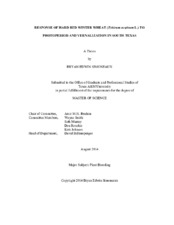| dc.description.abstract | The effects of vernalization and photoperiod on hard red winter wheat (Triticum aestivum L.; HRW) adaptation in the U.S. Great Plains is not well understood.
The main objectives of this study were to 1) characterize U.S. Great Plains HRW for vernalization requirement and photoperiod response and to 2) discern the association between the main effects of photoperiod (ΔP) and vernalization (ΔV) with yielding ability, plant height, days to heading, and vernalization and photoperiod marker data generated by the USDA-ARS Genotyping Laboratory in Manhattan, KS in 2010.
The Southern Regional Performance Nursery (SRPN) is a collection of experimental HRW lines from the Southern Region of the U.S. Great Plains. Of the 48 lines in the 2010 SRPN, 20 were selected for evaluation under growth chamber conditions at Texas A&M University in 2010, 2011, and 2012. Three photoperiod regimes were utilized to mimic short, optimum, and long day conditions (12 and 16 h of light in 2010 and 2011; 10, 14, and 16 h of light in 2012). Vernalized (6 wk; V; 2010, 2011, and 2012), moderately vernalized (3 wk; MV; 2012) and non-vernalized (0 wk, NV; 2010, 2011, and 2012) seedlings were transplanted into the different photoperiod regimes described above. Data was taken on days to head emergence and days to anthesis. Data compiled by the USDA-ARS at 30 field locations across the U.S. Great Plains was also utilized, including grain yield (ton ha^(-1)), yield stability (Eberthart and Russell stability parameters; β and δ^(2)), days to head emergence (d), and plant height (inch). Genotyping was done at the USDA-ARS genotyping lab in Manhattan, KS in 2010, using a K-Biosciences SNP pipeline and utilizing KASP chemistry. The Markers considered for this experiment were photoperiod marker PPD-D1 LD and markers for the three vernalization genes, Vrn-A1, Vrn-A1b and Vrn-D3. Basal vegetative period (BVP), a.k.a. intrinsic earliness, was measured as time for vernalized seedling to grow to anthesis in the long day photoperiod regime based on 2010 and 2011 evaluations. Furthermore, ΔV was measured as the difference in anthesis date between V and MV vernalization regimes under long day conditions, based on 2012 evaluation. Moreover, ΔP was measured as difference in days to anthesis between 16 and 12 h regimes in the vernalized seedlings based on 2010 and 2011 evaluations. There was a significant and positive correlation between ΔP and ΔV (r=0.55, P < 0.05). Our results also showed that taller and late-maturing HRW lines had larger ΔP and ΔV and were generally poor-yielding and less stable across environments. This was consistent in older HRW cultivars such ‘Kharkof’, ‘Scout 66’ and ‘TAM 107’. Our study confirmed that HRW lines that yielded well across a broad geographic area were generally photoperiod-insensitive and had lower vernalization requirements. This combination also appeared to be vital for HRW lines adapted to South Texas climates. | en |


